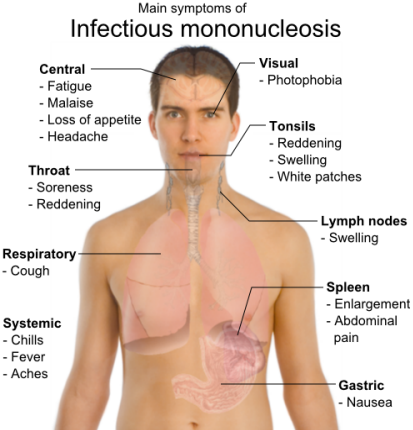Whether you call it Mono, HHV-4, Epstein-Barr Virus, Glandular Fever, EBV, Human Herpesvirus 4, the Kissing Disease or Infectious Mononucleosis, the viral infection can have varied types of pathology.
In some cases, the virus does little more than give you a sore throat and last only a few days, while in other cases you can have enlargement of the spleen, severe fatigue and several months of swollen lymph nodes. Some cases have been known to show no symptoms at all! Below is a general overview of all symptoms shown during any given infection.
Common cases of Infectious Mononucleosis last one to three weeks and
some may be so mild patients might not realize they have the
infection. Younger individuals and young adults experience
symptoms that develop slowly and may make the patient believe he or
she has a flu viral infection. Just plain not feeling good is
a general complaint as the virus starts to go into its active state.
 Following this symptom is headache, fatigue, chilliness, puffy
eyelids, and loss of appetite. As the virus develops within
the person's body the normal symptoms that we associate with Mono
come into play.
Following this symptom is headache, fatigue, chilliness, puffy
eyelids, and loss of appetite. As the virus develops within
the person's body the normal symptoms that we associate with Mono
come into play.
A
person with full blown symptoms will experience fever, sore throat,
and swollen lymph glands. Swollen lymph glands are typically
noticed near the side or back of the neck, but can be occasionally
seen in the groin area and in the armpit. Fevers generally
spike at 105° and are more commonly around the
101° mark. While this symptom is generally lost after a few
days, there are cases where the fever returns over one to three
weeks. High spikes in fever can
sometimes be associated with bacterial problems as well.
Lymph glands can swell to anywhere from the size of a bean to the size of a small egg. This swelling goes down over days or weeks depending on the case and patient. Another typical side effect of the viral infection is a swollen or enlarged spleen. In fifty percent of Mono cases the patients have enlarged spleens, and in twenty percent the liver is enlarged as well. Tonsillitis and difficulty swallowing are also common. Bleeding gums and in some rare cases, jaundice, can occur but this only lasts for a couple of days.
While this infection does typically effect high school through college age individuals, young children can also be infected. Symptoms of Mono in children are very different from adults and young adults. Symptoms are generally a mild sore throat or nothing at all and often goes completely unnoticed.
To find out if this virus can be cured and how it's diagnosed, click here!
